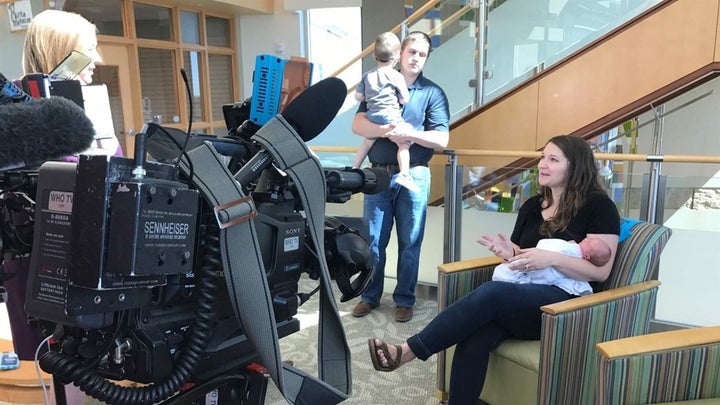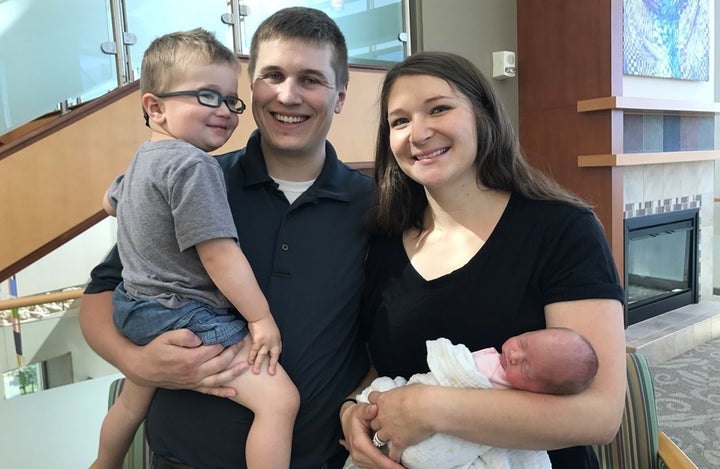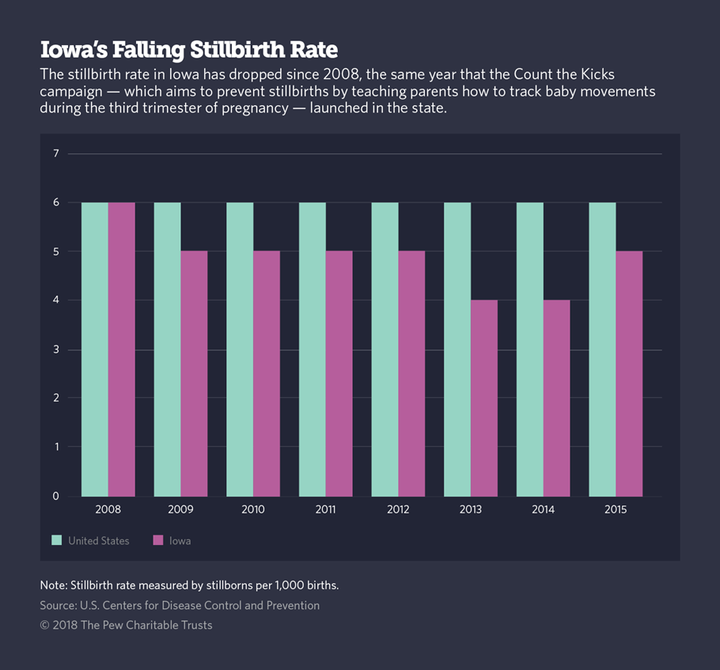
An Iowa TV station interviews Emily Eekhoff of Ankeny, Iowa, in 2017, soon after her daughter Ruby was born. Eekhoff said that “counting the kicks” in Ruby’s third trimester led her to alert her doctor to the baby’s distress and an emergency C-section that saved Ruby’s life. Her husband, Jeremy, holds their son, Liam.
Emily Eekhoff was in the 33rd week of her second pregnancy when she made an unsettling discovery.
As she had with her first baby, Liam, Eekhoff had been religiously keeping track of the number of kicks her unborn baby delivered during the third trimester.
This baby had been consistent, kicking about 10 times in a 10-minute period. But that day, in 2017, “I noticed she was not moving like she normally did,” Eekhoff, of Ankeny, Iowa, said. “That day, it was like three or four kicks in a couple hours.”
She alerted her doctor’s office and was told to immediately go to the hospital, where the staff detected a heartbeat, but couldn’t coax more movement. When an ultrasound revealed the baby was in distress, Eekhoff was quickly dispatched to an operating room for an emergency C-section.
Out came baby Ruby, with her umbilical cord wrapped three times tightly around her neck. “The on-call doctor who examined the ultrasound said that if they had waited even a day longer, she probably would have died,” Eekhoff recalled.
Ruby, now 15 months old and scooting around the house, was the beneficiary of the mothers-initiated campaign “Count the Kicks.” Started in 2008 in Iowa, it teaches mothers to track the movements of their unborn babies in the last trimester of pregnancy so they can quickly detect in utero distress. The campaign has corresponded to a nearly 28 percent drop in stillbirths in Iowa — and it is starting to spread.
Campaigns based on the Iowa model have been launched in Nebraska, Illinois, Kansas and Missouri, the last two just this year and both with state financing. Emily Price, executive director of Count the Kicks, the nonprofit behind the campaign, said there are plans for launches by the end of the year in Alabama and Ohio.
Many doctors have long urged pregnant women to pay attention to fetal kicks. But too many physicians still rely on what they glean from routine office visits, even though waiting for the next scheduled appointment may be too late, according to Jason Collins, a Louisiana obstetrician who has practiced for 30 years and has studied stillbirths.
“Mom is the best evaluator of the baby’s status,” Collins said. “Educating moms about kick counts is the path to preventing stillbirth.”
The campaigns, which put educational materials in the offices of all providers of maternity health care, cost little. In Kansas, for example, it is expected to cost about $9,000 a year, with the money coming from the state’s federal Title V Maternal and Child Health Services Block Grant, according to Rachel Sisson, director of the Kansas Department of Health and Environment’s Bureau of Family Health.
Grieving Mothers
In 2003, Tiffan Yamen, a marketing and sales executive who lived in the Des Moines suburb of Waukee, went into labor 10 days before her scheduled C-section.
It was her second delivery, and she felt comfortable waiting until the end of her workday before heading to the hospital, where she was monitored for the next six or seven hours. Several times, nurses noted, “You have a very sleepy baby.”
She was given medication to slow down her labor in the hopes of delaying delivery until closer to her due date and sent home. The next day, she woke up not feeling well and noticed her baby was not moving. But because the previous day’s tests hadn’t alarmed her caregivers, and no one had told her to pay particular attention to the baby’s movements, she wasn’t alarmed.
By coincidence, she had an appointment with her obstetrician that day. When she showed up with her 2-year-old, Isabela, in tow, the staff made a routine check for the baby’s heartbeat. Then, without a word of explanation, Yamen remembers her doctor exclaiming, “We need to get an ultrasound right away.” He scooped her up in his arms and rushed down the hall.
Yamen said she was more focused on Isabela, whom they had left alone in the other room, than the doctor’s frantic probing with the ultrasound. That is, until he abruptly pronounced the words she would not forget. “Tiffan,” he said, “I’m sorry. It’s too late.”
The next day, Yamen delivered the baby, posthumously named Madeline, stillborn.
It would later emerge that the baby’s umbilical cord had formed a knot around her neck, a frequent cause of stillbirths. The knot had apparently tightened with every contraction, cutting off the baby’s oxygen.

Emily and Jeremy Eekhoff with newborn Ruby and son Liam, 2, in 2017. Emily credits “counting the kicks” with saving Ruby, who was born with her umbilical cord wrapped tightly around her neck.
Because of how distraught Yamen was in the aftermath, she said her pastor put her in touch with another woman in his congregation who had just had a stillbirth. Together they connected with three other women, two of whom had also had stillbirths. The third woman had lost her baby within days of delivery.
The five women started meeting regularly at a coffee shop as an informal support group. As they learned how little was said about stillbirths outside medical circles, they began sharing ideas about how to help others. They settled on the idea of asking the state to create a stillbirth registry review panel, which would record all stillbirths in the state and investigate their causes.
As it happened, one member of their group was then-state Rep. Janet Peterson, a Democrat who is now a state senator. She introduced the bill to create the registry. It passed in 2004.
The women then headed to Washington, D.C., to seek funding for the registry, enlisting the help of then-U.S. Sen. Tom Harkin, an Iowa Democrat, who secured startup funding from the Centers for Disease Control and Prevention.
The Iowa registry became a model for registries elsewhere, in Hawaii, Atlanta, and parts of Colorado and New York.
The mothers’ group wasn’t done, though. Attending a 2009 summit in Washington on stillbirths, some wandered from sessions geared toward mothers to another area where childbirth researchers were presenting their findings.
There, Yamen heard about a study from Norway that had demonstrated the rate of stillbirths among expectant mothers who had received training in systematically tracking fetal movement fell by more than 40 percent.
“We said, ‘Wouldn’t it be cool if we did this in the United States?’” said Yamen, who in 2005 delivered another healthy baby daughter, Zoe.
The mothers’ group created Count the Kicks and planned to launch their first campaign at home, in Iowa. The state was encouraging, but said it didn’t have money to support the campaign. Instead, the March of Dimes donated $15,000. With that, Yamen said the group created brochures and contacted every provider of maternal health care in the state, offering them the educational materials to provide their patients.
Price, the executive director, said that at least 90 percent of the providers requested the materials.
‘We Don’t Want to Scare Moms’
The results have been impressive. Within five years, the stillbirth rate in Iowa dropped from 6.13 to 4.36 per thousand births (it ticked back up between 2015 and 2016, but declined again the next year, according to the Iowa Department of Public Health). While other factors might explain the reason for the drop, no one has identified any changes other than the campaign to explain it.
In 2012, the campaign added a free app that enables pregnant women to record their daily counts.
Price said that this year, the Iowa campaign has focused more on minority communities, in which the stillbirth rates are higher. Nationally, the stillbirth rate among black mothers in 2013 was 10.5, compared with 4.9 for whites. According to the Iowa Department of Public Health, in Iowa, the stillbirth rate among blacks was 8.1 compared with 4.1 for whites.

The Iowa campaign held focus groups this year with at-risk expectant mothers and their providers to try to design ways to reach them, Price said. “We know that without intentional focus on women of color, independent of income, we are likely to unintentionally widen disparities in stillbirth rather than decrease them.”
Price said that when the campaign began, she heard concerns from some obstetricians that counting fetal kicks would cause women undue anxiety, leading to unnecessary doctor visits. She said she has not heard any evidence that has happened, and in any case dismisses the concern.
“We don’t want to scare moms, but we think this is actually empowering for them.” The app, she said, gives the women strong data to present to doctors.
Many obstetricians are big supporters, including the director of the Missouri Department of Health and Senior Services, who brought the campaign to his state. “We are the first state health department to initiate and fund this,” said Director Randall Williams, who was a practicing obstetrician for 30 years. Missouri is using federal maternal block grant funds to finance the effort, about $24,000 this year, according to a department spokeswoman.
One of the early backers of the campaign in Iowa was Neil Mandsager, medical director of obstetrics at Mercy Medical Center in Des Moines, who performed the emergency C-section on Emily Eekhoff to deliver Ruby. He said that many women have, like Eekhoff, arrived at the center reporting diminished movement and requiring immediate deliveries.
“All of the credit goes to these five women who saw a gap in medical knowledge and took steps to fill it,” Mandsager said.

